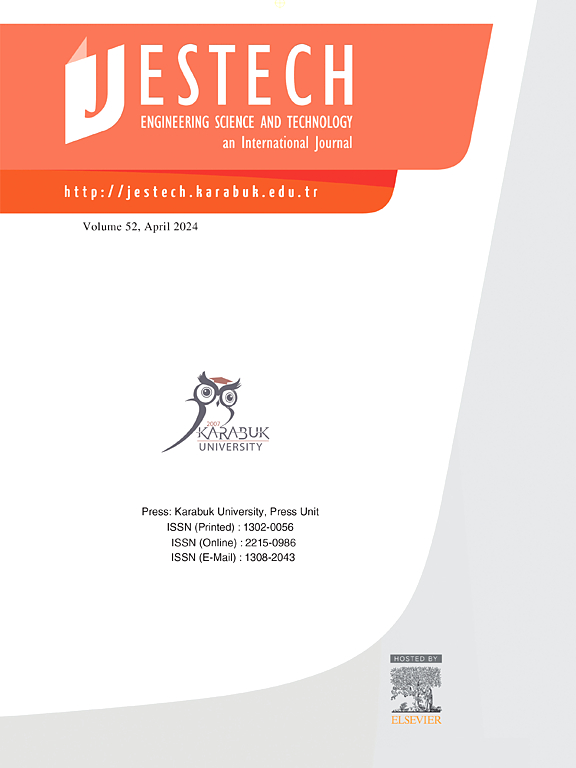Enhancing multi-class skin lesion diagnosis through ensemble learning of CNN and transformer architectures
IF 5.4
2区 工程技术
Q1 ENGINEERING, MULTIDISCIPLINARY
Engineering Science and Technology-An International Journal-Jestech
Pub Date : 2025-07-28
DOI:10.1016/j.jestch.2025.102145
引用次数: 0
Abstract
Skin cancer remains one of the most prevalent forms of cancer worldwide, highlighting the critical need for accurate and automated diagnostic systems to support early detection and improve patient outcomes. This study presents a deep learning-based framework for multi-class classification of dermoscopic skin lesion images using the HAM10000 dataset. A range of state-of-the-art convolutional neural networks (CNNs) — including DenseNet201, InceptionResNetV2, and Xception — were evaluated under both frozen and fully fine-tuned configurations. Additionally, the performance of Vision Transformer (ViT) architectures was assessed to examine their potential in skin lesion analysis. To enhance classification performance, ensemble learning strategies — namely hard voting, soft voting, and weighted soft voting — were implemented. Experimental results indicate that fully fine-tuned models outperform their frozen counterparts, with InceptionResNetV2(full) achieving the best individual performance with accuracy of 0.88% and F1-score of 0.77%. The highest overall performance was obtained using the proposed weighted soft voting ensemble, yielding an accuracy of 0.89% and an F1-score of 0.80%. These findings demonstrate the effectiveness of ensemble methods and transfer learning based models in advancing automated skin lesion classification. Moreover, the results highlight the potential and limitations of each architecture in clinical applications and provide valuable insights for future research in computer-aided dermatological diagnosis.
通过CNN和变压器结构的集成学习增强皮肤病变的多级诊断
皮肤癌仍然是世界上最普遍的癌症之一,因此迫切需要准确和自动化的诊断系统,以支持早期发现和改善患者的预后。本研究提出了一个基于深度学习的框架,用于使用HAM10000数据集对皮肤镜下皮肤病变图像进行多类分类。一系列最先进的卷积神经网络(cnn)——包括DenseNet201、InceptionResNetV2和Xception——在冻结和完全微调配置下进行了评估。此外,还评估了视觉变压器(ViT)架构的性能,以检查其在皮肤病变分析中的潜力。为了提高分类性能,采用了集成学习策略,即硬投票、软投票和加权软投票。实验结果表明,完全微调模型优于冻结模型,其中InceptionResNetV2(完全)获得了最佳的个人性能,准确率为0.88%,f1得分为0.77%。使用所提出的加权软投票集合获得了最高的整体性能,准确度为0.89%,f1得分为0.80%。这些发现证明了集成方法和基于迁移学习的模型在推进皮肤病变自动分类方面的有效性。此外,研究结果突出了每种结构在临床应用中的潜力和局限性,并为未来计算机辅助皮肤科诊断的研究提供了有价值的见解。
本文章由计算机程序翻译,如有差异,请以英文原文为准。
求助全文
约1分钟内获得全文
求助全文
来源期刊

Engineering Science and Technology-An International Journal-Jestech
Materials Science-Electronic, Optical and Magnetic Materials
CiteScore
11.20
自引率
3.50%
发文量
153
审稿时长
22 days
期刊介绍:
Engineering Science and Technology, an International Journal (JESTECH) (formerly Technology), a peer-reviewed quarterly engineering journal, publishes both theoretical and experimental high quality papers of permanent interest, not previously published in journals, in the field of engineering and applied science which aims to promote the theory and practice of technology and engineering. In addition to peer-reviewed original research papers, the Editorial Board welcomes original research reports, state-of-the-art reviews and communications in the broadly defined field of engineering science and technology.
The scope of JESTECH includes a wide spectrum of subjects including:
-Electrical/Electronics and Computer Engineering (Biomedical Engineering and Instrumentation; Coding, Cryptography, and Information Protection; Communications, Networks, Mobile Computing and Distributed Systems; Compilers and Operating Systems; Computer Architecture, Parallel Processing, and Dependability; Computer Vision and Robotics; Control Theory; Electromagnetic Waves, Microwave Techniques and Antennas; Embedded Systems; Integrated Circuits, VLSI Design, Testing, and CAD; Microelectromechanical Systems; Microelectronics, and Electronic Devices and Circuits; Power, Energy and Energy Conversion Systems; Signal, Image, and Speech Processing)
-Mechanical and Civil Engineering (Automotive Technologies; Biomechanics; Construction Materials; Design and Manufacturing; Dynamics and Control; Energy Generation, Utilization, Conversion, and Storage; Fluid Mechanics and Hydraulics; Heat and Mass Transfer; Micro-Nano Sciences; Renewable and Sustainable Energy Technologies; Robotics and Mechatronics; Solid Mechanics and Structure; Thermal Sciences)
-Metallurgical and Materials Engineering (Advanced Materials Science; Biomaterials; Ceramic and Inorgnanic Materials; Electronic-Magnetic Materials; Energy and Environment; Materials Characterizastion; Metallurgy; Polymers and Nanocomposites)
 求助内容:
求助内容: 应助结果提醒方式:
应助结果提醒方式:


